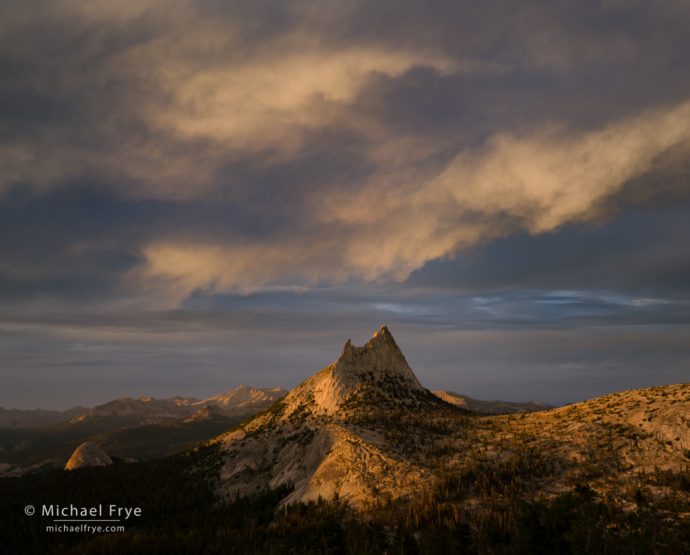Summer is the dry season in California. Typically, in most of the state, one sunny day follows another, for months on end.
But there are a couple of exceptions. Along the coast, summer is the foggiest time of year. Fog can be so persistent that some spots may barely see the sun for days, or even weeks.
And in the high mountains the sunshine parade can be interrupted by periods of afternoon showers and thunderstorms. All it takes is for some moist, subtropical air to push up into the state from Mexico. That warm, moist air then gets lifted by the mountain slopes, triggering condensation, clouds, atmospheric instability, and thunderstorms.
We’ve been in one of those periods lately, with frequent afternoon thunderstorms in the high country. These storms are usually very localized, and therefore hard to predict. Forecasts can tell you, perhaps, when and where thunderstorms are most likely to occur, but the exact location and timing of a particular cell can make a big difference photographically – the difference between seeing a rainbow, or a spectacular sunset, versus finding completely uninteresting skies.
Last Tuesday the weather looked a little different. While possible showers were predicted for the higher elevations of the Sierra, forecast models showed more widespread afternoon clouds than usual – clouds apparently associated with a weak front.
I’m always willing to drive up to the mountains on short notice when there’s interesting weather, but driving is one thing, and making a long hike is another. I’d been looking for the right time to hike to a spot I’d picked out, with an expansive view, and a prominent peak in the foreground. But reaching this spot would involve about an eight-mile roundtrip hike, with a 1,600 foot elevation gain. I’d like a little higher odds if I’m going to make that kind of effort.
Tuesday seemed like a day when the odds would be a little higher, so Claudia and I drove into the park, and set out on our hike. Along the way I kept my eye on the clouds, and there were lots of them – too many perhaps, especially to the northwest. It seemed that those clouds could block the sunset. But the last satellite photos I’d been able to see showed the clouds moving east, with clear skies behind them to the west. So it seemed possible that the sun could crawl underneath those clouds as it set.
And sure enough, just as I reached my spot, the sun started to light some lower ridges. As the sun sank lower, the light gradually climbed higher, eventually reaching all the peaks, and the clouds. You can see my favorite moment in the photograph above.
Some clouds did eventually block the very latest light, so we started hiking down. We made most of the return journey in the dark, with headlamps, but we’re used to that. Hiking back in the dark after photographing a sunset a pretty common event in our lives. We got back to our car at around 10:30, and pulled into our driveway at about 12:45 a.m. We were tired, of course, but it was such a beautiful hike, and so much fun.
— Michael Frye
Related Posts: Just Another Summer in the Yosemite High Country; Monsoon Sunsets
Michael Frye is a professional photographer specializing in landscapes and nature. He is the author or principal photographer of The Photographer’s Guide to Yosemite, Yosemite Meditations, Yosemite Meditations for Women, Yosemite Meditations for Adventurers, and Digital Landscape Photography: In the Footsteps of Ansel Adams and the Great Masters. He has also written three eBooks: Light & Land: Landscapes in the Digital Darkroom, Exposure for Outdoor Photography, and Landscapes in Lightroom: The Essential Step-by-Step Guide. Michael has written numerous magazine articles on the art and technique of photography, and his images have been published in over thirty countries around the world. Michael has lived either in or near Yosemite National Park since 1983, currently residing just outside the park in Mariposa, California.










Very nice photograph Michael. This’s a wonderful spot to photograph, and it’s in my list to one day visit and photograph. Have a great day
Thank you Martin!
Beautiful sunset and photo! Always enjoy your work. Which trail did you take? Did you see any wildlife? Have a wonderful week!
Thanks Rosanna! I think we saw a deer or two… or are you concerned about bears?
I love the composition and lighting of this photograph! Beautiful!
Thanks Miriam!
Beautiful light, expertly captured! I appreciate your effort! Thanks for sharing the story!
Thank you Claire!
A beautiful composition and lighting, especially the light on the clouds and mountain.
Thanks Ian!
Thank you for the moment of serene beauty captured here. It must be easier to enter the Park than I imagined? You are lucky to have a willing partner for late night hikes.
Thanks Gery. I don’t know what you imagine; you need a day-use reservation, or a hotel or campground reservation inside the park. And yes, I am lucky, in many ways!
Been wanting to photograph that peak for years, only done it in daylight such as last September with boring blue sky, been worried about the hike back in the dark. Also did it a few years ago on the last day Tioga Rd was open that year, got lost for a little bit as snow covered the trail. One of these days….thanks for sharing, Michael.
You’re welcome Harri – and better luck next time.
Beautiful, Michael. Once again you prove the old adage, chance favors the prepared mind. 🙂
Thank you John!